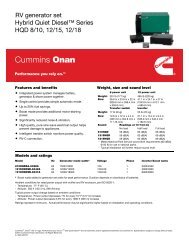Air Brake Manual
Air Brake Manual
Air Brake Manual
Create successful ePaper yourself
Turn your PDF publications into a flip-book with our unique Google optimized e-Paper software.
<strong>Brake</strong> Adjustment<br />
(A driver should be trained in brake adjustment prior<br />
to attempting practical examination and supply the<br />
equipment required to do a brake adjustment.)<br />
The following are recommended steps to determine<br />
if an S-cam brake with manual slack adjusters<br />
requires adjustment.<br />
· Ensure vehicle is secure and wheels blocked.<br />
· Verify reservoirs are at full pressure.<br />
· Shut off the engine, leaving the transmission in a<br />
low gear or park.<br />
· Release the spring parking brakes.<br />
· Make a chalk mark where the push rod enters the<br />
brake chamber, repeat this on all the brake<br />
chambers.<br />
· Reapply the spring parking brakes and measure<br />
the distance from the brake chamber to the chalk<br />
mark. Ensure the slack (push rod travel) is within<br />
1/2 and 3/4 inches or within manufacturer’s<br />
specifications and the angle between the slack<br />
adjuster and push rod is 90° or as close as<br />
practical. If not, then a brake adjustment is<br />
required.<br />
The following are recommended adjustment steps<br />
for S-cam brakes with manual slack adjusters.<br />
· Ensure the vehicle is secure and the wheels are<br />
blocked.<br />
· Release the spring parking brakes.<br />
· Verify reservoirs are at full pressure.<br />
· Use a wrench to disengage the external locking<br />
device (if so equipped) from the adjustment bolt of<br />
the slack adjuster.<br />
· Turn the adjustment bolt until the brake lining<br />
contacts the brake drum. If possible, visually<br />
check to see that the brake linings are in contact<br />
with the brake drum.<br />
· When turning the adjustment bolt on the slack<br />
adjuster, the S-cam should turn in the same<br />
direction as if a brake application were being<br />
made.<br />
· Back off the adjustment bolt about 1/4 to 1/2 of<br />
a turn.<br />
· Now recheck slack adjuster travel. Check that the<br />
push rod free travel is now between 1/2 to 3/4<br />
inches, or within manufacturer’s specifications.<br />
<strong>Brake</strong> Test<br />
· Reapply the spring parking brake, remove wheel<br />
blocks.<br />
· Gently tug against the spring parking brakes in<br />
low gear, it should hold the vehicle.<br />
· Release the spring parking brakes and set trailer<br />
brakes with the hand valve.<br />
· Gently tug against trailer brakes in low gear.<br />
· Move vehicle ahead slowly and make a service<br />
brake application to check brake response.<br />
<strong>Air</strong> Over Hydraulic (<strong>Air</strong> Actuated) <strong>Brake</strong> System<br />
The pre-trip air brake inspection should be<br />
completed within 20 minutes. Failure to complete the<br />
test within 20 minutes may result in the test being<br />
discontinued.<br />
Practical examination will be conducted in either<br />
the metric or imperial systems of measurement,<br />
whichever coincides with the equipment being<br />
operated.<br />
Vehicle Secure<br />
· Apply the parking brake on the vehicle.<br />
· Block the wheels; the vehicle should be on level<br />
ground if possible.<br />
· Check hydraulic fluid level in the reservoir.<br />
· Check under the hood for hydraulic fluid leaks.<br />
· Check that the compressor is secure.<br />
· Check the drive belt and pulleys for wear,<br />
cracking, slippage and tension (if equipped).<br />
· Drain all air reservoirs completely (wet/supply air<br />
reservoir first). When air reservoirs are empty<br />
close the drain valves. “For testing purposes only,<br />
the applicant will not be required to manually<br />
drain the reservoirs. Instead, the applicant will<br />
verbally explain the steps that they would follow<br />
when draining the reservoirs and then fan the<br />
brake pedal to empty the reservoir”.<br />
· Check wheel cylinders and lines for signs of<br />
hydraulic fluid leaks.<br />
75




